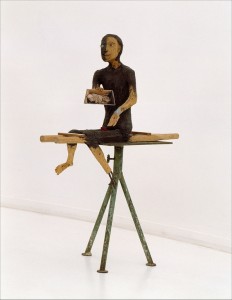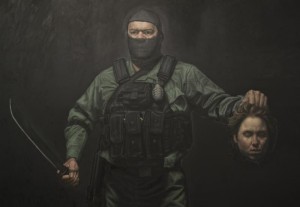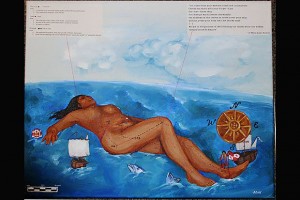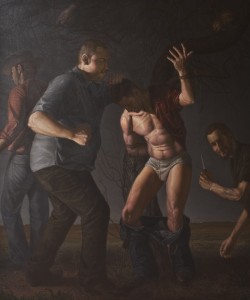Despite the fact that the brutal treatment of the native population throughout American history is often an avoided topic, its parallels to the treatment of immigrants today are startling. Beginning in the 15th century upon the arrival of Europeans in the Americas and continuing throughout time, natives have experienced incredible physical and cultural destruction as they have been targeted for their differing beliefs and practices. The initiation of this treatment came when Christopher Columbus, a Genoese explorer, came across the Americas in 1492 on an exploration mission funded by the Spanish monarchy. In their new colonies Spaniards sought both to spread Christianity throughout the native population as well as acquire resources from the land and natives. Through the exploitation of natives and their lands and introduction of European diseases into the Americas, the Spanish forced natives to assimilate into European culture destroying their ancient traditions, reduced the authority of clan leaders in the native’s political matters through enslavement and persecution, and forced natives to convert to Christianity, shattering the spiritual practices they had held for centuries.
Similarly to the natives, immigrants to the Americas, beginning in the early 20th century, often experience great strife with the conflicting North American cultures upon their arrival. The European immigrants that arrived in America during the early 1900s were subjected to persecution and differential treatment because of their country of origin. Often people, such as Irish immigrants, were considered by more inherently American people to be criminals and lesser than themselves. Although this notion was not naturally supported, the incredibly low pay given to these immigrants could often only sustain a low-class lifestyle and subsequently supported the perception that these people were lesser than other Americans. In present day America, immigrants coming from American countries south of the Texan border, especially Mexican immigrants, seem to be the focus of our nation’s distrust and dislike of immigrants. Many North Americans accuse these immigrants of taking jobs that citizens of the United States could have, using government funding without paying taxes, and not assimilating to North American culture through methods such as continuing to speak languages native to their countries of origin. Whether these statements are true or not, they still have a major impact on the disparity felt between Americans who believe themselves the only rightful citizens and the immigrants that flee to our country seeking freedom from the struggles of their own.
The disputes, regardless of whether they are rooted in economic or cultural differences, still hinder the immigrants’ ability to access the freedom they seek in the Americas. Although resulting from different peoples, both modern-day immigrants and the native Americans desired freedom from various types of oppressors. Native Americans sought to revert back to times of their ancestors, in which they were free to practice religion and conduct their society as they pleased. Immigrants, on the other hand, sought freedom from the religious and cultural oppressors their ancestors experienced in their homelands as well as economic liberation through more jobs and better pay. Thus, while immigrants sought the American dream of freedom found in their history, immigrants seek the American dream of freedom in their future. In addition to the similarities found in their struggles for freedom, both the natives and modern-day immigrants are a vital component to the American society of their time. Natives were instrumental in the various trade systems that Europeans developed, and immigrants are necessary laborers on many of America’s farms In my collection I look to highlight the parallels between the struggles of these two very different groupings of peoples in order to grasp a fuller understanding of the American desire for freedom and the reality in which it exists.
”The Magician, 2002” Tina Barney // In this photograph, Barney is able to display the American dream in its most innocent form, happy and thriving children. These children are able to attend a celebration because of the freedom that they have been allowed.
“Cornfield, 2011” Tina Barney // In “Cornfield” Barney takes a picture of a woman in small town America against the corn that is being grown by other people in her town.
“La Malinche” Jimmie Durham // La malinche is a famous Mexican figure viewed by many Mexicans as the mother of the people and the most typical victim. Jimmie Durham points to the struggles that she, as a Native American, suffered at the hands of the Spanish colonizers conquering the Aztec Empire.
 Jimmie Durham, “Jesus. Es geht um die Wurst”, 1992 // Jimmie Durham shows the struggle that Native Americans experience with their religious practices, since their belief in Jesus, a Christian notion, stems from the forceful cultural assimilation of the European colonizers.
Jimmie Durham, “Jesus. Es geht um die Wurst”, 1992 // Jimmie Durham shows the struggle that Native Americans experience with their religious practices, since their belief in Jesus, a Christian notion, stems from the forceful cultural assimilation of the European colonizers.
“Contrabando y Traicion” Rigoberto A Gonzalez // Gonzalez works to portray the violence that occurs as a result of drug and cartel violence throughout the border region between Mexico and the United States. In this painting he portrays the man being harmed by cartel members similar to the fashion in which Jesus was painted in Caravaggio paintings. Through this Gonzalez is able to add character to the tales of the Mexican drug smugglers and their victims without simply narrating them as a journalist.
 “Perseus with Head of Medusa” Rigoberto Alonso Gonzalez // Gonzalez keeps with his theme of portraying perpetrators and victims of drug violence in a Baroque-style painting, and he adds to this by showing the relationship between drug violence and biblical violence. The head of this woman is very similar to the many old baroque and renaissance paintings that show head of St. John the Baptist.
“Perseus with Head of Medusa” Rigoberto Alonso Gonzalez // Gonzalez keeps with his theme of portraying perpetrators and victims of drug violence in a Baroque-style painting, and he adds to this by showing the relationship between drug violence and biblical violence. The head of this woman is very similar to the many old baroque and renaissance paintings that show head of St. John the Baptist.
 “”Tierra y Libertad” Melanie Cervantes // In her graphics, Cervantes likes to display the difficulties that immigrants face in America. In “Tierra and Libertad”, Cervantes displays the little kid with a machete used to cut the corn that is etched into the birchwood on which this is printed on. In addition, the white hat that the kid has on is symbolic of his Guatemalan heritage, which points to immigrants’ desires to sustain their native cultures.
“”Tierra y Libertad” Melanie Cervantes // In her graphics, Cervantes likes to display the difficulties that immigrants face in America. In “Tierra and Libertad”, Cervantes displays the little kid with a machete used to cut the corn that is etched into the birchwood on which this is printed on. In addition, the white hat that the kid has on is symbolic of his Guatemalan heritage, which points to immigrants’ desires to sustain their native cultures.
 “Xicana Classic” by Nani Chacon // In her works, Chacon attempts to place Native American women into a culture that they have otherwise attempted to have been removed from. In “Xicana Classic” Chacon inserts a Native American woman into the pinup era, a time which primarily features white women. Both immigrants and native americans experience separation from American culture, despite the desire for a free and equal country.
“Xicana Classic” by Nani Chacon // In her works, Chacon attempts to place Native American women into a culture that they have otherwise attempted to have been removed from. In “Xicana Classic” Chacon inserts a Native American woman into the pinup era, a time which primarily features white women. Both immigrants and native americans experience separation from American culture, despite the desire for a free and equal country.
 In her piece “Her Empire Is Her Reality” Sierra Edd attempts to draw awareness to the impact left behind on natives by the colonization of the Americas by Europeans. Edd wishes to bring a more native narrative to her work, instead of strictly abiding to the Eurocentric one that has been forced up native people throughout the century.
In her piece “Her Empire Is Her Reality” Sierra Edd attempts to draw awareness to the impact left behind on natives by the colonization of the Americas by Europeans. Edd wishes to bring a more native narrative to her work, instead of strictly abiding to the Eurocentric one that has been forced up native people throughout the century.
 “La Virgin de Guadalupe” shows the religious syncretism that took place between native Mexican and European cultures, as the Virgin Mary transformed into “La Virgin de Guadalupe”. This displays the lack of religious freedom experienced by Mexicans upon their colonization.
“La Virgin de Guadalupe” shows the religious syncretism that took place between native Mexican and European cultures, as the Virgin Mary transformed into “La Virgin de Guadalupe”. This displays the lack of religious freedom experienced by Mexicans upon their colonization.



